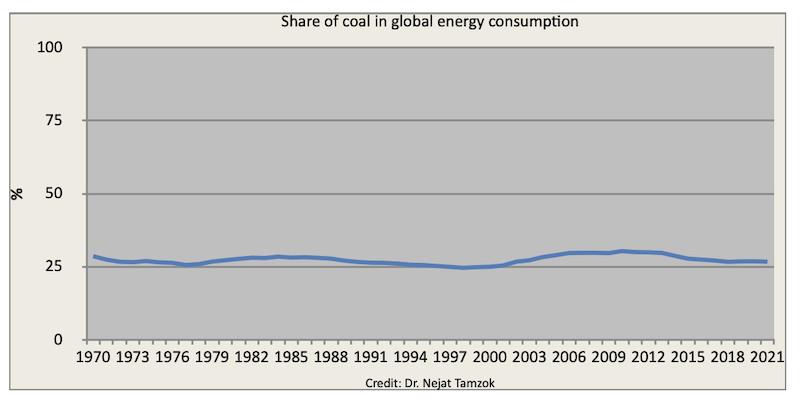IEA’s Coal Predictions: Realistic Or Wishful Thinking? – Analysis
The International Energy Agency (IEA) released its “World Energy Outlook 2023” recently.
The document presented was like a declaration that the fossil fuel era is now in decline.
The report estimates that global oil and natural gas consumption will peak before 2030 and never increase again. In 2040, only 17 years later, the share of fossil fuels in primary energy consumption will decline from 80 percent to 65 percent, and their share in electricity generation will decline from 70 percent to 40 percent.
The most striking predictions in the report are those related to coal: Global coal consumption will begin to decline rapidly in the next few years, and approximately 35 percent less coal will be consumed in 2040 compared to today. Thus, it is estimated that the share of coal in global energy consumption, which is 27 percent today, will decrease to 17 percent in 17 years, and its share in electricity generation will decrease from 45 percent to 22 percent.
Moreover, these predictions were made based on a scenario that takes into account the energy policies that countries are pursuing today. In another scenario that assumes that the commitments made under the Paris Agreement or the net zero emission targets will be realized, the share of coal in both primary energy and electricity generation will decline to approximately 12 percent in 2040. In the third scenario, in which global warming is limited to 1.5 degrees Celsius, coal will almost completely disappear from the world’s agenda 17 years from now.
The IEA provides several basic justifications for this table.
Firstly, the IEA predicts that conflict and uncertainty environments similar to those experienced today in Ukraine or the Middle East will accelerate the transition from fossil fuels to clean energies. In other words, energy crises that come with geopolitical tensions will also hasten the end of the fossil fuel era, with coal being the first to be hit.
On the other hand, it is estimated that China’s economic slowdown will continue in the coming years, and the rate of increase in energy consumption will decrease accordingly. Therefore, it is predicted that coal demand in this country, which consumes 55 percent of the coal produced in the world, will decline significantly.
The IEA is also considering the fact that clean energy investments, particularly solar energy, are much higher than fossil fuel investments. The Agency projects that approximately 80 percent of new electricity generation capacity to be installed by 2030 will use renewable energy sources, with solar energy accounting for more than half of that. This will lead to a rapid increase in the production capacity of clean energy systems worldwide, especially solar photovoltaic modules and electric vehicle batteries. The IEA expects that all of these developments, along with the increasing interest in nuclear energy in recent years, will bring about the end of coal.
We cannot yet know to what extent IEA’s predictions will come true. However, it is always a good idea to be careful when it comes to coal. If you ask why, this dirty fuel has survived many challenges in the past; its grave has been dug many times, but it has always reappeared on the energy scene, sometimes even stronger.
After all, coal provides approximately a quarter of the world’s energy consumption, and this position has remained almost unchanged for fifty years. It is true that its pace has slowed in the last few years, but this slowdown is largely due to North America and Europe. However, when we turn to the Asia-Pacific region, we find a much different picture. The coal hunger of this region, which consumes more than 80 percent of the coal produced in the world, does not seem to be satisfied easily. Last year, global coal consumption broke a new record, and the reason for this is the consumption records in the Asia-Pacific geography, led by China and India. India’s coal consumption has increased by 50 percent over the past 10 years. In the same time period, countries such as Vietnam, Indonesia, Pakistan, and the Philippines have seen increases ranging from 150 percent to 300 percent.
An analysis of the future of coal that focuses only on the issue of global warming is incomplete. It should not be forgotten that for many countries, giving up coal is also equivalent to giving up energy security and even national security, and that coal is still means of escaping poverty and ensuring social welfare. The need for electrification in countries with low per capita electricity consumption will continue to be one of the most important sources of demand for coal in the coming years. On the other hand, millions of people in many countries around the world, especially in China, India and Russia, earn their living from coal production, transmission or distribution. Therefore, for these countries, transitioning out of coal also means facing serious economic and social problems.
Indeed, on the same dates as the IEA’s report launch, different winds were blowing in Cape Town. At the African Energy Week, which is considered to be Africa’s largest energy event, the emphasis was on increasing fossil fuel use for the development and prosperity of the continent, in contrast to the agency’s estimates. At the event with a large participation from many countries around the world, while slogans such as “Coal is back” or “The world is experiencing a renaissance in coal” were prominent on the one hand, on the other hand, the idea that coal should continue to be a part of the energy equation for the security of developing countries was being loudly voiced.
Of course, humankind should be able to use cleaner and more efficient energy sources than coal. There is no doubt that this will be the trend, and coal will eventually be phased out at some point in the future. But it’s good to be realistic: The fate of coal will be determined not by international agreements, but by the preferences and strategies that nation-states will define in line with their own interests. Therefore, it would be overly optimistic to expect this leading actor of global warming to easily leave the stage.


